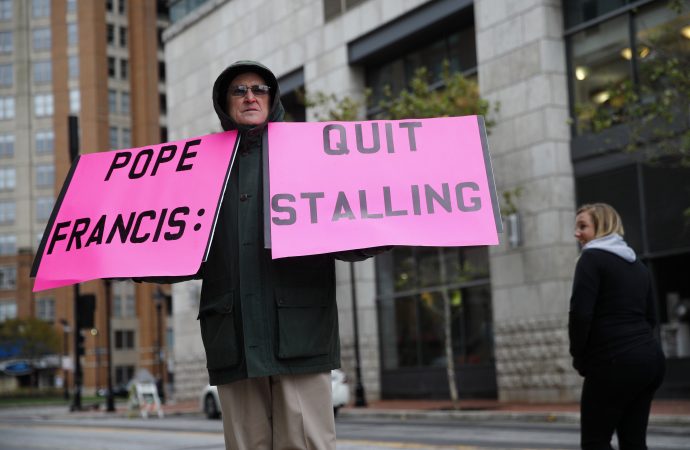Now that the dust has settled on the U.S. bishops’ fall meeting in Baltimore - which was keenly anticipated in the run-up, and which turned out to be massively anti-climactic in the aftermath - it’s time to take preliminary stock of where things stand in the bishops’ efforts to respond to the clerical sexual abuse crisis.
The agenda for the meeting was waylaid late afternoon on Sunday, when a letter reached Cardinal Daniel DiNardo of Galveston-Houston, President of the USCCB, from Canadian Cardinal Marc Ouellet, Prefect of the Vatican’s Congregation for Bishops, telling the bishops to delay votes on matters related to the abuse crisis until Feb. 21-24, when Pope Francis has summoned presidents of all the bishops’ conferences around the world for a summit on child protection.
Some bishops floated taking non-binding votes on the abuse proposals, the centerpiece of which was the creation of an independent commission to investigate bishops accused of violating anti-abuse standards, and a new code of conduct for the bishops themselves. In the end, no such non-binding votes were taken.
While much remains uncertain about what happened and where things go from here, here’s what we do know with reasonable certainty.
First, there were apparently serious problems under canon law, the body of law for the Catholic Church, with several aspects of the proposed measures. Critics worried that the proposed commission for instance, would cede a dubious amount of authority to its six lay and three clergy members, giving them a sort of joint power of supervision with the pope. Others were concerned that the commission, which was to be set up as a separate 501(c)3 non-profit corporation funded by dioceses directly rather than the conference, would be essentially unaccountable.
Still other bishops felt the proposed code of conduct risked being overly generic, leaving it unclear precisely what it was bishops would be held accountable for either doing or not.
As a result, it became obvious to many observers that had a vote been held, even of a non-binding nature, the proposals may not have generated the two-thirds support within the conference necessary to be adopted.
The proposals came out of discussions within the USCCB Administrative Committee in September and October, and sources told Crux that many of the same issues that came up in floor discussions in Baltimore had also surfaced within the committee. The final version of the proposals was only sent to Rome for review on Oct. 30, and the bishops didn’t see them until early November, leaving little time for a thorough review.
Further, no new clarity emerged in Baltimore about a Vatican investigation of the case of ex-Cardinal Theodore McCarrick that Pope Francis ordered on Oct. 6, the conclusions of which, Rome said at the time, will be announced “in due course.” Those findings are keenly anticipated, given wide consensus that only the Vatican possesses the needed answers about who facilitated his rise to power, and who knew what when about allegations of misconduct.
“Both abuse and its cover-up can no longer be tolerated and a different treatment for bishops who have committed or covered up abuse, in fact represents a form of clericalism that is no longer acceptable,” the Oct. 6 Vatican statement said.
Discussion in Baltimore also appeared to surface something of a generational difference among the bishops, with younger bishops often more eager to see steps taken immediately. Many served as priests post-2002 under the terms of the Dallas charter and norms, observers said, making it more irritating they’re now being blamed for not following standards, and they’re less inclined to buy Rome’s traditional rhythms as an explanation for why they can’t get answers on McCarrick right away.
Finally, so far there has been no announcement from the Vatican of who will be organizing that February meeting, or what its agenda might be. However, there are some indications that one step Rome may be considering is a strengthened role for Metropolitan Archbishops in supervising bishops of smaller dioceses in his regions -or, if accusations of standards violations are lodged against the Metropolitan himself, to the senior suffragan.
DiNardo appointed an ad hoc panel of past presidents to study two different options - one a special commission, and the other using Metropolitans as to deal with accusations against a bishop. He also asked the group to consider national guidelines for the publication of names of credibly accused clerics.
So, where does all that leave things?
To begin with, it would suggest the U.S. bishops have some work to do to refashion their proposals ahead of the February summit, in order to ensure they have a realistic possibility of passing muster. It’s worth noting that the bishops will meet again before then, for a prayer retreat suggested by Francis Jan. 2-8. Granted, that’s not a business meeting, but it does provide a chance to take the temperature of the body informally.
As a footnote, Francis from the beginning has been pressing bishops to a “pastoral conversion.” It likely would go a long way to putting the pontiff at ease to see the bishops taking that retreat seriously - showing up for it, to begin with, and entering into the spirit of Capuchin Father Rainero Cantalamessa’s reflections on the mission of the apostles and their successors.
In addition, there’s now a three-month window for the leadership of the American bishops, in tandem with their closest allies in Rome, to get across to relevant Vatican offices and to the pope himself the pastoral urgency of seeming serious, beginning with getting to the bottom of the McCarrick case. Rank-and-file anger in America over what’s happened over the last six months, combined with perceptions of delay in responding, is real.
Bottom line: The expectation was that November would be decisive in terms of how the U.S. Church would come to grips with its “summer of shame.” As it turns out, November was simply a way station in the journey to February - which means that February had better deliver.

